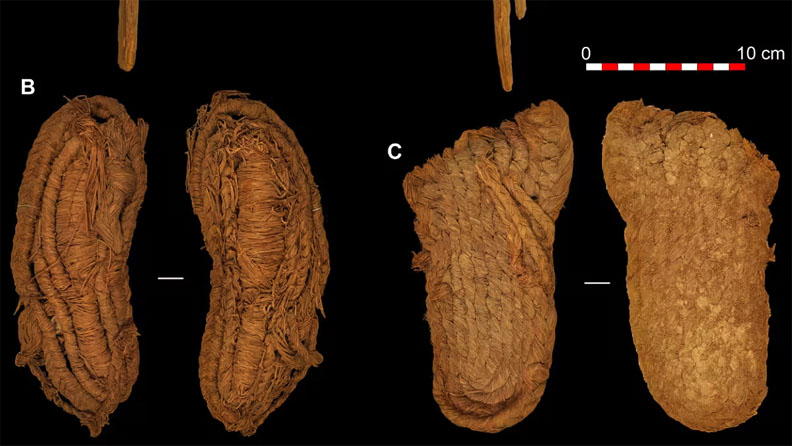
 In 2023, the world got acquainted with some of the most astonishing discoveries in the field of arts, archaeology and literature. A still-glimmering sword to the oldest shoes ever found in Europe to the emergence of the name of the author of a 17th-century Spanish play – many discoveries kept the world engaged as well as ‘awe-struck’ as they hoped for more.
In 2023, the world got acquainted with some of the most astonishing discoveries in the field of arts, archaeology and literature. A still-glimmering sword to the oldest shoes ever found in Europe to the emergence of the name of the author of a 17th-century Spanish play – many discoveries kept the world engaged as well as ‘awe-struck’ as they hoped for more.
Here are some of the most significant discoveries made in the year 2023.
Sword that ‘still shines’
A sword, made of bronze and estimated to be more than 3,000 years old, was unearthed in southern Germany in such a well-preserved state that it “almost still shines”. There was an octagonal hilt on the sword and it was found in a grave in which three people were buried in quick succession – a man, a woman and a boy.
6,000-year-old sandals in Spanish bat cave
Scientists said that the sandals found buried in a bat cave in southern Spain are likely to be the oldest footwear ever found in Europe, adding that they appeared to be 6,200 years old. The sandals, tools and baskets, which belonged to the 19th century, were found at a hunter-gatherer burial site in the Cueva de los Murciélagos, also known as the “cave of the bats,” close to the southern city of Granada.
AI helps discovery author
After remaining a mystery for centuries, the name of the author of a 17th-century Spanish play emerged. It turned out to be the work of the famous author Felix Lope de Vega. The researchers were able to recognise the author using the AI technology, which was helping them transcribe some 1,300 anonymous manuscripts and books and cross check them against works by known authors.
A royal lavatory
Archaeologists in February found the oldest known flush toilet in the world. The lavatory and bent pipe, which is estimated to be 2,400-year-old, may have been a status symbol among China’s elite. It was found in the ruins of a palace located at the Yueyang archaeological site in the city of Xi’an.
Hidden hallway in the Great Pyramid of Giza
A 30-foot hidden and mysterious corridor was discovered in the Great Pyramid of Giza, as part of the Scan Pyramids project which had used technology including cosmic-ray imaging and infrared thermography for a better understanding of its architectural intricacies and unknown areas.
Lost necklace in ocean bed
A new necklace, which had a tooth of the prehistoric shark Megalodon, was found in the wreckage of the ocean liner by the deep-water investigation company Magellan, which had undertaken an ambitious project for producing a full-size scan of the ship that was discovered sitting some 13,000 feet deep in the Atlantic Ocean after the infamous disaster in 1912.
4,000-year-old Stonehenge-like sanctuary
A 4,000-year-old sanctuary was unearthed in the town east of Rotterdam, which appeared to be similar to Stonehenge. The site in Tiel was being excavated by the archaeologists since 2017 and finally, they were able to find a 4,000-year-old sanctuary which they believe was designed in a way so that it aligns with the sun on solstices.
THE MOST POWERFUL LIGHT FROM THE SUN
Among the new astronomical records set in 2023 was an announcement of the highest-energy gamma ray ever seen coming from the sun, an order of magnitude more powerful than had previously been seen.
“The sun is more surprising than we knew,” Mehr Un Nisa, an astronomer at Michigan State University and one of the authors who described the discovery in Physical Review Letters, said in a statement.
VELA PULSAR SMASHES GAMMA-RAY ENERGY RECORD
More record-breaking gamma-rays were detected in 2023, with photons pushing 20 TeV detected coming from the pulsar within the Vela supernova remnant.
A pulsar is a spinning neutron star that consists of the remains of a massive star that once went boom in a supernova. Pulsars are normally detectable at radio wavelengths, but some of them also emit gamma-rays, thought to be produced by electrons spiraling around the phenomena’s intense magnetic-field lines.
THE UNIVERSE’S BIGGEST EXPLOSION
The most intense, long-lasting and powerful explosion ever seen — ten times brighter than any known supernova and still erupting even now — was discovered in a galaxy whose light has been traveling to us for 8 billion years, according to new research revealed in May in the Monthly Notices of the Royal Astronomical Society. Cataloged as AT2021lwx, the explosive event was co-discovered by the Zwicky Transient Facility in California and the Asteroid Terrestrial-impact Last Alert System (ATLAS) in Hawaii, which looks for transient events in the sky that can be anything from a moving asteroid to a flaring cosmic explosion.
THE MOST DISTANT FAST RADIO BURST
The most distant fast radio burst (FRB) ever detected was revealed in 2023. A report in the Oct. 19 issue of the journal Science described how, on June 19, 2022, an FRB was spotted having traveled through space for a gargantuan 8 billion years. FRBs are mysterious. They are short bursts of radio waves that last mere milliseconds, yet in that short fraction of time they can emit as much energy as our sun does in 30 years. Nobody knows what produces them; often, they are seen to go off randomly in the universe. Sometimes, they are even seen to repeat. Magnetars, which are extremely magnetic neutron stars, are the main suspect. The record-breaking burst was detected by the Australian Square Kilometer Array Pathfinder (ASKAP), which is a group of 36 radio dishes. ASKAP pinpointed the location of the burst, cataloged as FRB 20220610A, which then allowed the Very Large Telescope in Chile to follow up and identify the source as a system of two or three colliding galaxies that we see as they were 8 billion years ago.
NASA CONFIRMS THE HOTTEST SUMMER ON RECORD
NASA’s Goddard Institute of Space Studies (GISS) in New York confirmed that the Northern Hemisphere summer in 2023 experienced the warmest summer since its temperature records began in 1880, a consequence of human-caused global warming coupled with the effect of El Niño, which helped raise sea temperatures.
GISS scientists compare global temperatures by relating them to the average summer temperatures between 1950 and 1980. They found that June, July and August combined were on average 0.23 degrees Celsius (0.41 degrees Fahrenheit) warmer than the 1950–1980 average. August alone was 1.2 degrees Celsius (2.2 degrees Fahrenheit) warmer. This might not sound like much, but efforts to mitigate climate change rely on keeping global warming to less than 1.5 degrees Celsius above the pre-industrial average.
MOST ANCIENT SUPERMASSIVE BLACK HOLE DETECTED
It’s fitting that, as the most expensive telescope ever built, the James Webb Space Telescope (JWST) is routinely breaking new astronomical records, with one of the standouts being the discovery of the most distant supermassive black hole known to exist in the universe.
The JWST spotted the black hole in a galaxy called CEERS 1019, which we see as it existed about 13.3 billion years ago (just 570 million years after the Big Bang).





Be the first to comment